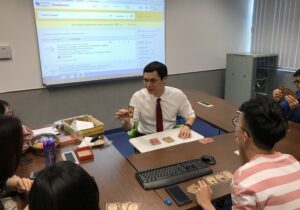by Chris Chan
Head of Information Services at Hong Kong Baptist University Library
“Let’s play a game.” These are not words that I usually utter during library instruction. But it is a phrase that will become more common, if the results of a recent experiment are anything to go by.
During my ten years as an instruction librarian, student engagement during information literacy (IL) sessions has been a persistent challenge. I know that the practices and dispositions that librarians are teaching are vital to their success, and in many cases the students themselves recognize this too. Yet the one-off nature of much of the instruction that takes place at my library means that students are often expected to learn these abilities devoid of any meaningful context.
Over the years, my colleagues and I have experimented with various ways to increase engagement. PowerPoints have been replaced with Prezis, and lengthy librarian monologues or demonstrations are now interspersed with questions posed via online polls that students can respond to via their smartphones. Wherever feasible, hands-on exercises are incorporated into instruction. Nevertheless, in our feedback surveys the effectiveness of activities is consistently rated lower than the relevance of the session itself.
In my interpretation, this is indicative of a need on our part to do more to design engaging instruction sessions. How does this relate to playing games? When implemented effectively, games and gamification have the potential to provide the spark that seems to be missing from our instruction programme. As Jennifer Young writes in her 2016 article on using games to teach information literacy:
Good educational games will motivate and engage students, provide context for information in the course, offer satisfying work that puts students in a state of “flow,” and encourage collaboration and social learning.
Of course, designing a good educational game is easier said than done. Many of the games described in the literature are digital, which presents an additional technical barrier. Recently, however, I stumbled across a physical card game called Search&Destroy. Designed by librarians at Ferris State University, it challenges students to use their database searching abilities to be the last person standing. Essentially, players draw keyword and modifier cards, and must run searches on a chosen database. The goal is to avoid running a search that returns zero results.
This concept intrigued me, and I purchased a copy to experiment with it. First I ran through the game with fellow librarians, and it was a tremendous amount of fun. There is definitely a certain thrill to saddling your opponent with cards that make their searches much more difficult (e.g. item must be in French!).
Our next step was to find out if students enjoyed the game as much as librarians. At HKBU Library we run regular learning events for which students receive a required co-curricular credit. As the Library has control over the content of these sessions, they were a natural place to play the game with students in an informal setting.
So on the afternoon of 5 March 2018 I found myself sitting with a group of six students explaining the rules of the game. I served as a sort of referee, guiding play around the circle. They quickly got the hang of it, and became very engaged in the competitive aspects, with some players forming impromptu alliances to gang up on and eliminate mutual foes.
The design of the game produced many teachable moments. For example, one of the cards allows a player to use the OR operator in their search statements, which led to a discussion of why this is beneficial if your goal is to avoid 0 search results.
At the end of all learning events we do a quick anonymous survey. For the Search&Destroy event, all students either agreed or strongly agreed that they had learned something interesting or useful. Qualitative comments included: “very good game, new experience” and “interesting and good”, which indicate that for this small group at least, the activity was successful in teaching search skills in an engaging manner.
While the overall experience was great, after reflection I identified several areas that could be improved or considered further. First, the game took much longer than the expected 15 minutes. I was hoping to fit in at least two rounds of the game, but ended up with just one that took almost 45 minutes. This was partly due to the number of players, and also due to the fact that we used the Library’s discovery service as the database for the game. Because of its wide coverage of full text content, it took some time before players were at risk of getting 0 results. More specialist disciplinary databases could produce quicker rounds.
Another future consideration is how to best incorporate the game into typical course-integrated instruction (as opposed to a one-off event). An activity like this would be great for introductory first-year courses, but such sessions typically have 20-30 students. Running multiple simultaneous sessions of the game in a class would be possible, but quite intensive in terms of staffing resources.
Scaling up in this way will definitely be a challenge, but it is one that I am keen on exploring after this positive initial experience with game-based instruction.
For those attending LOEX 2018 interested in learning more, librarians from Ferris State will be running an interactive workshop.
This article gives the views of the author and not necessarily the views the Centre for Evidence Based Library and Information Practice or the University Library, University of Saskatchewan.


